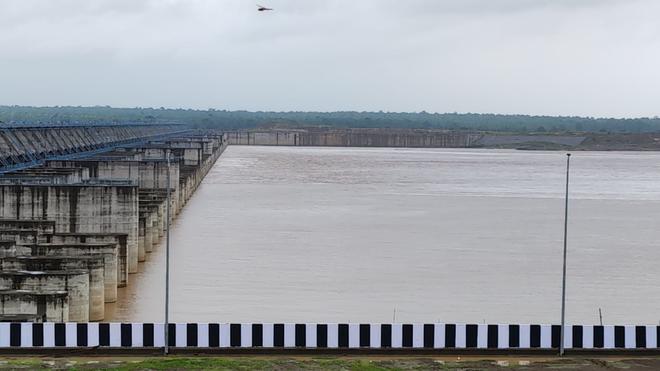
The recent incident of sinking and drift of 6 out of 11 piers in the Block-7 of Medigadda (Laxmi) Barrage of the prestigious Kaleshwaram Lift Irrigation Project (KLIP) has forced the authorities of Irrigation department to plan for a detailed investigation of the foundation of all the 8 Blocks with a total of 85 gates as a “measure/purpose of safety”.
A decision has been taken to conduct a detailed investigation of not just the disturbed piers and the Block but the entire barrage that withstood the highest-ever recorded flood of 28.7 lakh cusecs on the intervening night of July14-15 in 2022, against the designed discharge capacity of 28.25 lakh cusecs.
“Although the disturbance/damage of the six piers has no impact on other piers in the Block (7) and also on the blocks on either side, we have decided to go for sub-surface investigation of the foundation of the pier blocks to plan for preventive measures as the barrages are constructed without any break analysis as done in the case of dams,” a highly-placed official source told The Hindu.
Explaining the process of restoration work, the source said any detailed sub-surface investigation would require dewatering of the river bed abutting the damaged block first and it would be possible only with the construction of a coffer dam to prevent the water flow reaching the area. Only the exterior examination of the damage was possible to the National Dam Safety Authority (NDSA) team of experts that visited the barrage site on October 24.
During the meeting the NDSA team had with the senior authorities/engineers of the Irrigation department the next day, the initial view was that the cause of damage could be a change in the river morphology after last year’s record flood, sand deposit sift/consolidation beneath the foundation of piers or piping developed in the river bed after the July 2022 flood.
“We have furnished every piece of information sought by the NDSA expert team and they are likely to submit their report soon to the Central Water Commission with the recommendations for remedial action. The restoration work could range from removal of the disturbed piers or the entire Block and constructing it afresh and it could take about four months after commencement,” the source explained.
The official explained that the design of barrages would be such that all blocks would act independently and any damage to a block would not have any impact on others. “In spite of the damage to Block-7 of the Medigadda Barrage it’s very much possible, if necessary for Rabi crops, to lift water as only 94 metres water level is sufficient for running pumps against the 100-meter FRL (full reservoir/barrage level) of Medigadda Barrage,” he stated.
What Irrigation officials say about dams and barrages
Foundation of dams is laid after going to the depth of rock-bed, while for barrages it’s on the river bed with sand deposits. It’s difficult to go till the depth of rock-bed for laying foundation of barrages.
Storage of water in dams is 70% against the concrete wall/structure and 30% against gates, whereas in barrages, small volume of water is stored on the river bed against gates for the purpose of diversion.
State Dam Safety Authority officials visited the barrage site on Saturday to examine the damage. Drift of piers in barrages not uncommon. Farakka and Dowlaiswaram barrages too had similar events in their initial year.
Officials say, there’s no problem with the design and construction quality of the Barrage.







